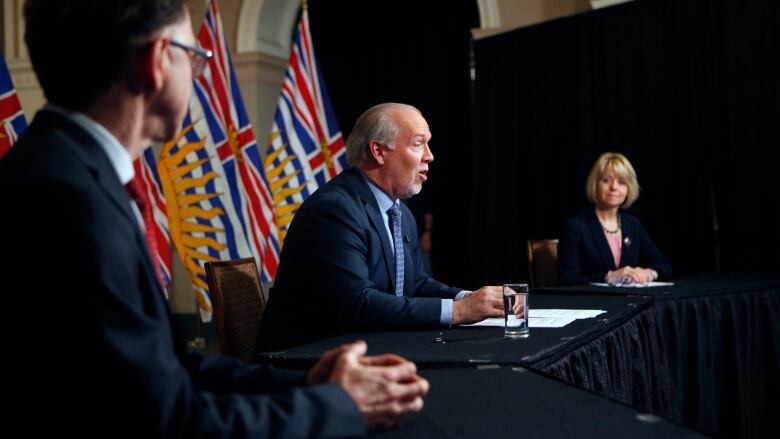B.C. to spend $1.6B, hire thousands of health-care workers for flu season
Province seeks to minimize impact of influenza, boost capacity to track COVID-19

B.C. will spend $1.6 billion and hire 7,000 health-care workers in a bid to prevent a combination of COVID-19 and influenza from straining its health-care system this fall and winter, officials announced Wednesday.
A key part of the strategy, announced by Premier John Horgan, Health Minister Adrian Dixand Dr. Bonnie Henry, the provincial health officer, involves reducing the usual demand for hospital beds by reducing seasonal flu cases, while boosting hospitalsurge capacity if there is a sudden influx of patients.
The plan will inject $1.6 billion into the health-care system and involve the hiring and training of 7,000 health-care workers. It aimsto avoid a scenario where surgeries must be widely delayed, as the province did in the spring as part of its emergency response to the pandemic.
It will also be launching a major vaccination campaign against influenza, with the goal of vaccinating nearly twomillion people, compared to the yearly average of around 1.4 million.
"Our pandemic plan has been working,'' said Horgan. "We need to accelerate. We need to up our game.''
Henry said B.C.'s vaccination strategy will be on a scale "not yet seen" and encouraged everyone in the province over the age of six months to get vaccinated against influenza.
She said the province has been tracking COVID-19 cases in the Southern Hemisphere, whichis just coming out of its influenza season. Influenza season in the Northern Hemisphere usually starts in October and November, peakingin December and January.
"The good news is that their immunization rates were very high. This triggered us to buy more vaccine here," she said, adding that measures like physical distancing, masksand hand-washing also protect againstinfluenza.
The plan also focuses on boosting the capacity for contact tracingandCOVID-19 testing, with the goal of being able to test 20,000 people per day, compared to the current capacity of around 8,000 to 10,000.
B.C. will also launch a "hospital-at-home" program, where eligible patients will receive treatment in their own homes, further easing demand forhospital beds and preventing the spread of the virus within health-care settings. The province says it has 533 "base beds" for COVID-19 patientsspread across 19 hospitals.
The new approach will also manage hospitals by region, meaning there will be nosystem-wide reduction in hospital bed occupancy, like the one implemented in March.
Another key part of the plan is to protect B.C.'s vulnerable seniors population, which bore the brunt of the pandemic in the spring. Two thousand more staff will be hired in the province's long-term care homes, along with 5,000 additional health-care aides.
The province has also ordered 45,000 FluzoneHigh-Doses of the influenza vaccine for high-risk seniors,which will be made available to all residents of long-term care and assisted living facilities.
Dix said the province is preparing for four potential scenarios:
- Low COVID-19 cases similar to the number of cases recorded in the province in June, with a maximum of 57 people in acute care.
- Moderate COVID-19 cases, with a maximum of 98 people in acute care.
- High COVID-19 cases similar to the number of cases recorded in the province between March andMay, with a maximum of 201 people in acute care.
- An extreme number of COVID-19 cases twice as many cases as those recorded between March and May 2020, with up to 400 people in acute care.
Horgan said he is confident the province's plan will protect the health-care system in the coming months.
"Seven months later, we know a great deal more than we did then. I'm very confident that the plan announced today will create more safety in our long-term care sector. Our acute care sector will be better prepared.We will continue to put in place the resources British Columbians need," he said.
On Tuesday, Henry announced that 429 new cases of COVID-19 were recorded in B.C. over the long weekend,bringing thetotal number of cases since the pandemic beganto 6,591.
A number of exposure events at nightlife venues caused the province to amend public health orders on Tuesday,ordering nightclubs and stand-alone banquet halls closed, ending the sale of liquor at restaurants past 10 p.m. and telling venues to reduce the volume from music or other sources to conversational levels.
The amendment represented the first time B.C. has significantly pulled back on steps that had been taken to reopen the province since May.
Henry also reiterated that B.C. residents should be easing up on social interactions as the fall approaches, reining in bubbles to five or six people,emphasizing the province must keep community transmission of COVID-19 low to allow schools to safely reopen.
"Could I have predicted these numbers? No. These numbers are concerning to us, but they don't reflect the widespread community transmission that hasoverwhelmed health-care systems," she said.
WATCH | Henry endorsesHalloween:













_(720p).jpg)


 OFFICIAL HD MUSIC VIDEO.jpg)
.jpg)



























































































